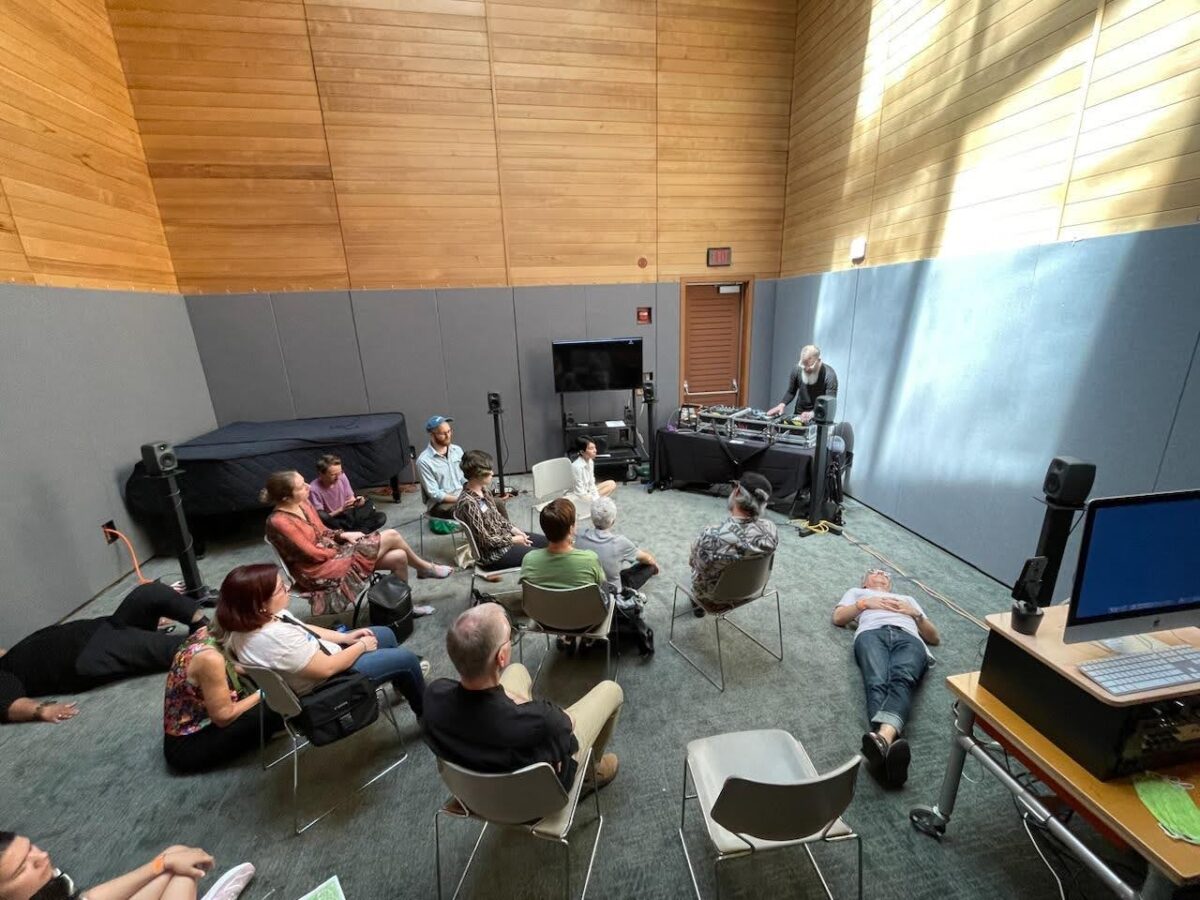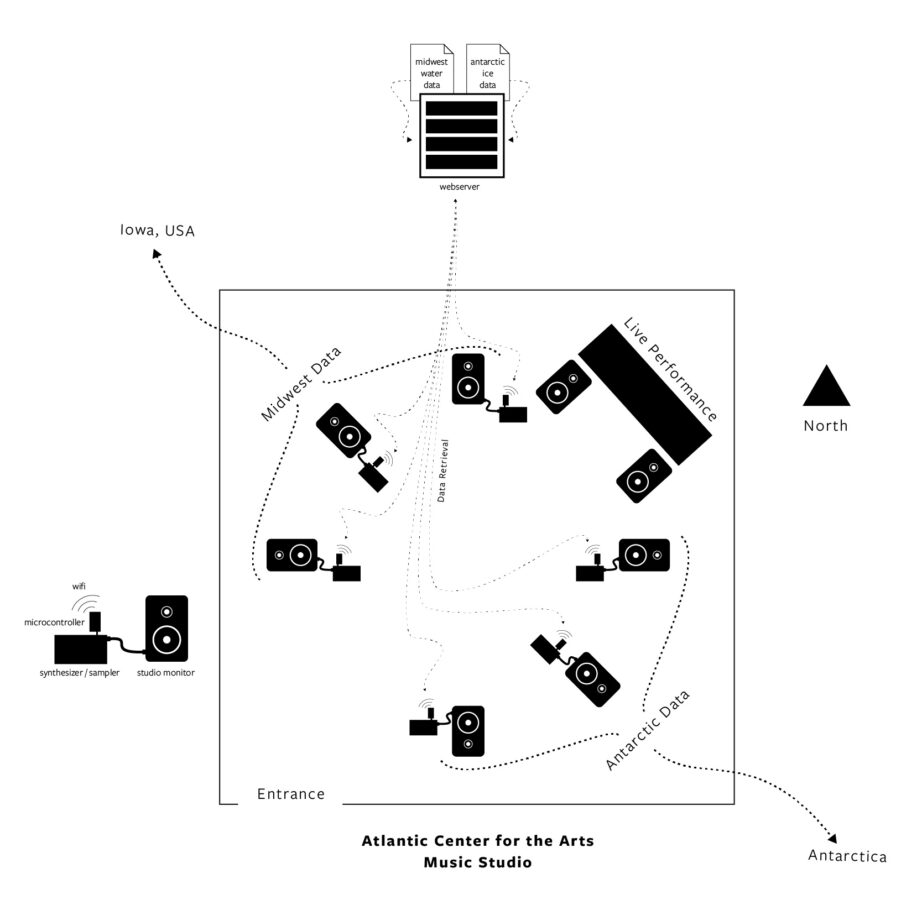Six channel sonification installation and live performance.

Authors: Dr Diana Chester and Alex Braidwood
Submitted to the Proceedings of the 2023 the World Forum for Acoustic Ecology conference at the Atlantic Center for the Arts
This work takes as its starting point recorded sounds and measurements of water from North America, the Arctic, and Antarctica. Using field recordings, data measurements, and multiple temporalities as a factor for composition, we decode the recordings and measurements to make audible the various forms of ecological memory and story held within water. These include water quality data, sea-ice thickness, glacial weather data, and recordings made underwater and on the land.
Sub_Merge is a space and time for active listening consistent with a meditative practice, a mediation on the collective experiences possible within water. The embedded performance creates a boundary for shared listening, while the 6-channel installation is amorphous, unfolding over the 12-hour installation – a timescale allowing for engaged listener participation.
Sub_Merge is a speculative soundscape for listeners to emerge with stories and new understandings of water in all its myriad forms. It creates a new collective listening experience built from an historical record of water’s Listening Pasts, and new knowledge for Listening Futures, from the memories held within water.
Collaboration, Theme of Water, and Data Sonification
Sub_Merge was born out of a conversation between Alex Braidwood and Diana Chester at a Board meeting of the World Listening Project, during a discussion about proposed work for the World Forum for Acoustic Ecology. Both realised a joint interest in data sonification and had existing work based around bodies of water. This led to a discussion on the acoustic ecology of water as the site of exploration for a new work, Sub_Merge developed for WFAE. The six channel installation utilises data sonification of water and air temperature datasets from June and July 2022 from West Okoboji Lake in Iowa and Davis Science Station in Antarctica, as well as audio recordings made by the artists of water and ice from these sites.
Their working sessions were conducted via Zoom between Iowa, USA where Braidwood is based and Sydney, Australia where Chester is based. During their collaborative discussions Braidwood shared work with buoy sensor data from West Okoboji Lake, while Chester had been working with Ice Mass Balance buoy data from Davis Science Station. They had both developed previous data sonification projects and exchanged ideas and approaches to the process of sonification. Through these discussions they decided to collaborate on a project that pooled their ideas and approaches to audio recording and sonification, while focussing on the shared theme of water.
Sub_Merge is an installation that uses data sonification to explore the changes to water and ice temperature in Lake Okoboji and around Davis Science Station, at the same time of year (June & July 2022), one located in the northern hemisphere and the other in the southern hemisphere. Braidwood had spent time recording the sounds of water in its varied states in West Okoboji Lake, and Chester, through a partnership with the Australia Antarctic Division, sent equipment down to collaborators in Antarctica who were able to make recordings of sea-ice on location. During their early collaboration meetings they decided to include samples of recorded sounds of water and ice in the installation as a means of bringing the recorded sonic texture of water to the otherwise MIDI created sonified sounds. This aesthetic decision laid the shape for both the final installation and the live performance that Braidwood gave at WFAE.
Installation Setup and Live Performance

Figure 1. Sub_Merge installation diagram at the Atlantic Center for the Arts Music Studio
The six audio channels of the installation [Figure 1] are a collection of independent performance machines, each performing the data of an assigned sensor. Three channels are performing temperature data from Antarctic ice, and three are performing temperature data from West Okoboji Lake in Iowa, located in the upper midwest of the United States. The two data sources are from the same period, June and July of 2022. Throughout the installation, data from each source is performed from the same collection time.
To determine the pace of the composition, the procedural timing of how the data is stepped through was determined by the exhibition’s duration. When a performance machine requests data at each interval, the code uses the local time to determine what percentage of the total installation time has elapsed to select which records are returned. This process was developed so the full data set would be experienced throughout the duration of the installation without needing to repeat records from the data set.
Each performance machine is based on a wifi-enabled microcontroller that accesses a script running on a web server to retrieve a single piece of data, turn that data into a MIDI command, and then send that MIDI data to trigger a synthesizer or sampler. For this installation, the six performance machines were assigned three to the Antarctic ice data and three to the Iowa lake data. Two of those machines for each data set were synthesizers, and one was a sampler loaded with hydrophone recordings from each location. In total, there were four synthesizers and two samplers.
Within the space, the speakers were organized in a ring facing inwards. The positioning of performance machines was determined by where the data was collected, with Antarctic ice data coming from south of the installation location and Iowa lake data from north-northwest.
During the installation, Braidwood performed live within the space on two additional channels to create an eight-channel experience for the duration of the performance. The performance utilized sounds from both data sites and sampled language to create a collective listening experience and guided meditation. Listeners were encouraged to slow down and make themselves comfortable. Many sat in the provided chairs inside the ring of speakers while others sat on the floor, laid down, or sat against the wall during the shared listening experience. The forty-five-minute performance was designed to follow the energy level of a dawn chorus, the time when an environment transitions from night to daytime. It starts slowly with small punctuations of insects and crickets with low rumbling pulsations. It moves through the development of looping rhythms and patterned structures that build while shifting in and out of phase. The composition settles into a steady rhythm, with layers of sources all finding their place comfortably in the overall scene that’s been created.
The relationship between the live two-channel performance and the six-channel sonification was largely serendipitous. The sonification audio maintained its sequence moving through and performing the data during the performance, allowing Braidwood to respond in real-time with the created compositions.
Data References
West Okoboji Lake Temperature Data
Buoy Location: West Okoboji Lake, Iowa
Managed by: Iowa Lakeside Lab Regents Resource Center and The Global Lake Ecological Observatory Network
Accessed: June and July, 2022
https://wqdatalive.com/public/470
Antarctic Sea-Ice Temperature Data
Ice Mass Balance Buoy
Davis Science Station
Research project run by Dr. Petra Heil
Managed by: Australia Antarctic Division
Accessed: June and July, 2022
https://data.aad.gov.au/